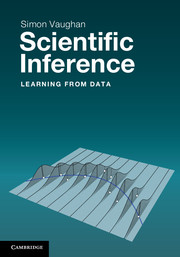Book contents
- Frontmatter
- Dedication
- Contents
- For the student
- For the instructor
- 1 Science and statistical data analysis
- 2 Statistical summaries of data
- 3 Simple statistical inferences
- 4 Probability theory
- 5 Random variables
- 6 Estimation and maximum likelihood
- 7 Significance tests and confidence intervals
- 8 Monte Carlo methods
- Appendix A Getting started with statistical computation
- Appendix B Data case studies
- Appendix C Combinations and permutations
- Appendix D More on confidence intervals
- Appendix E Glossary
- Appendix F Notation
- References
- Index
Appendix E - Glossary
Published online by Cambridge University Press: 05 June 2014
- Frontmatter
- Dedication
- Contents
- For the student
- For the instructor
- 1 Science and statistical data analysis
- 2 Statistical summaries of data
- 3 Simple statistical inferences
- 4 Probability theory
- 5 Random variables
- 6 Estimation and maximum likelihood
- 7 Significance tests and confidence intervals
- 8 Monte Carlo methods
- Appendix A Getting started with statistical computation
- Appendix B Data case studies
- Appendix C Combinations and permutations
- Appendix D More on confidence intervals
- Appendix E Glossary
- Appendix F Notation
- References
- Index
Summary
addition rule The rule for combining probabilities of events Pr(A ∪ B) = Pr(A) + Pr(B) − Pr(A ∩ B)
Bayes' theorem In its simplest form Bayes' theorem states Pr(A∣B) = Pr(B∣A) Pr(A)/Pr(B) and can be used to transpose the conditionals, i.e. relate A∣B to B∣A
bias Quantifies how far the average statistic lies from the parameter it is estimating
binomial The distribution of the number of successes obtained in a series of n independent trials, when the probability of success (per trial) is p
bootstrap A resampling scheme allowing randomised datasets to be produced by resampling from the existing data
box plot Graphical representation of numerical data based on Tukey's five-number summary
bubble plot A type of scatter plot using circles as the plotting symbols, with the areas of the circles representing a third variable
central limit theorem States that the mean of n random variables tends to variable with a Gaussian distribution as n → ∞ (under quite general conditions)
central moment The Nth-order central moment is the mean (expectation) of the Nth power of the deviation of a random variable from its mean
chi-square In general the sum of squares of ν independent normal variables has a chisquare distribution with ν degrees of freedom
chi-square statistic Test statistic formed from the (weighted) sum of squares of differences between data and prediction (model)
chi-square test A goodness-of-fit test that compares the chi-square statistic to a chi-square reference distribution
- Type
- Chapter
- Information
- Scientific InferenceLearning from Data, pp. 214 - 218Publisher: Cambridge University PressPrint publication year: 2013

